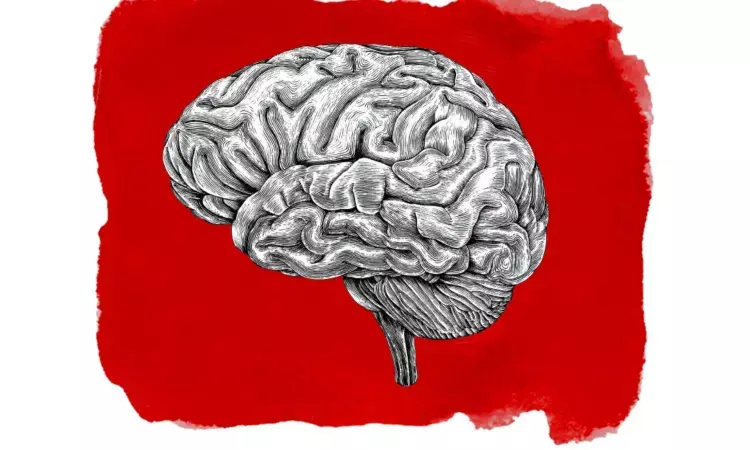- Home
- Medical news & Guidelines
- Anesthesiology
- Cardiology and CTVS
- Critical Care
- Dentistry
- Dermatology
- Diabetes and Endocrinology
- ENT
- Gastroenterology
- Medicine
- Nephrology
- Neurology
- Obstretics-Gynaecology
- Oncology
- Ophthalmology
- Orthopaedics
- Pediatrics-Neonatology
- Psychiatry
- Pulmonology
- Radiology
- Surgery
- Urology
- Laboratory Medicine
- Diet
- Nursing
- Paramedical
- Physiotherapy
- Health news
- Fact Check
- Bone Health Fact Check
- Brain Health Fact Check
- Cancer Related Fact Check
- Child Care Fact Check
- Dental and oral health fact check
- Diabetes and metabolic health fact check
- Diet and Nutrition Fact Check
- Eye and ENT Care Fact Check
- Fitness fact check
- Gut health fact check
- Heart health fact check
- Kidney health fact check
- Medical education fact check
- Men's health fact check
- Respiratory fact check
- Skin and hair care fact check
- Vaccine and Immunization fact check
- Women's health fact check
- AYUSH
- State News
- Andaman and Nicobar Islands
- Andhra Pradesh
- Arunachal Pradesh
- Assam
- Bihar
- Chandigarh
- Chattisgarh
- Dadra and Nagar Haveli
- Daman and Diu
- Delhi
- Goa
- Gujarat
- Haryana
- Himachal Pradesh
- Jammu & Kashmir
- Jharkhand
- Karnataka
- Kerala
- Ladakh
- Lakshadweep
- Madhya Pradesh
- Maharashtra
- Manipur
- Meghalaya
- Mizoram
- Nagaland
- Odisha
- Puducherry
- Punjab
- Rajasthan
- Sikkim
- Tamil Nadu
- Telangana
- Tripura
- Uttar Pradesh
- Uttrakhand
- West Bengal
- Medical Education
- Industry
White matter hyperintensities increase after menopause among women, finds study

Women who have gone through menopause may have more of a brain biomarker called white matter hyperintensities than premenopausal women or men of the same age, according to a new study published in the June 29, 2022, online issue of Neurology, the medical journal of the American Academy of Neurology.
White matter hyperintensities are tiny lesions visible on brain scans that become more common with age or with uncontrolled high blood pressure. These brain biomarkers have been linked in some studies to an increased risk of stroke, Alzheimer's disease and cognitive decline.
"White matter hyperintensities increase as the brain ages, and while having them does not mean that a person will develop dementia or have a stroke, larger amounts may increase a person's risk," said study author Monique M. B. Breteler, MD, PhD, of the German Center of Neurodegenerative Diseases (DZNE), in Bonn, Germany, and a member of the American Academy of Neurology.
"Our study examined what role menopause may have on amounts of these brain biomarkers. Our results imply that white matter hyperintensities evolve differently for men and women, where menopause or factors that determine when menopause starts, such as variations in the aging process, are defining factors."
The study involved 3,410 people with an average age of 54. Of those, 58% were women, and of the women, 59% were postmenopausal. Also, 35% of all participants had high blood pressure and of those, half had uncontrolled high blood pressure.
All participants had MRI brain scans. Researchers looked at the scans and calculated the amount of white matter hyperintensities for each participant. Average total volume for these brain biomarkers was 0.5 milliliters (ml). Average total brain volume was 1,180 ml for men and 1,053 ml for women. Average total white matter volume, the area of the brain where white matter hyperintensities can be found, was 490 ml for men and 430 ml for women.
After adjusting for age and vascular risk factors such as high blood pressure and diabetes, researchers found that postmenopausal women had more of these brain biomarkers when compared to men of similar age. In people 45 and older, postmenopausal women had an average total white matter hyperintensities volume of 0.94 ml compared to 0.72 ml for men. Researchers also found that the increase in brain biomarkers accelerated with age and at a faster rate in women than in men.
Premenopausal women and men of a similar age did not have a difference in the average amount of white matter hyperintensities.
Researchers also found that postmenopausal women had more white matter hyperintensities than premenopausal women of similar age. In a group of participants ages 45 to 59, postmenopausal women had an average total volume of white matter hyperintensities of 0.51 ml compared to 0.33 ml for premenopausal women.
There was no difference between postmenopausal and premenopausal women using hormone therapy. Breteler said this finding suggests that hormone therapy after menopause may not have a protective effect on the brain. Unrelated to menopausal status, women with uncontrolled high blood pressure had higher amounts of this brain biomarker compared to men.
"It has been known that high blood pressure, which affects the small blood vessels in the brain, can lead to an increase in white matter hyperintensities," said Breteler. "The results of our study not only show more research is needed to investigate how menopause may be related to the vascular health of the brain. They also demonstrate the necessity to account for different health trajectories for men and women, and menopausal status. Our research underscores the importance of sex-specific medicine and more attentive therapy for older women, especially those with vascular risk factors."
Reference:
Thurston, Rebecca C. PhD1; Aizenstein, Howard J. MD, PhD1; Derby, Carol A. PhD2; Sejdić, Ervin PhD3; Maki, Pauline M. PhD4 Menopausal hot flashes and white matter hyperintensities, Menopause: January 2016 - Volume 23 - Issue 1 - p 27-32 doi: 10.1097/GME.0000000000000481
Dr Kamal Kant Kohli-MBBS, DTCD- a chest specialist with more than 30 years of practice and a flair for writing clinical articles, Dr Kamal Kant Kohli joined Medical Dialogues as a Chief Editor of Medical News. Besides writing articles, as an editor, he proofreads and verifies all the medical content published on Medical Dialogues including those coming from journals, studies,medical conferences,guidelines etc. Email: drkohli@medicaldialogues.in. Contact no. 011-43720751


